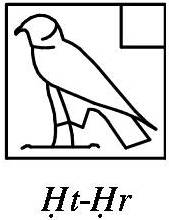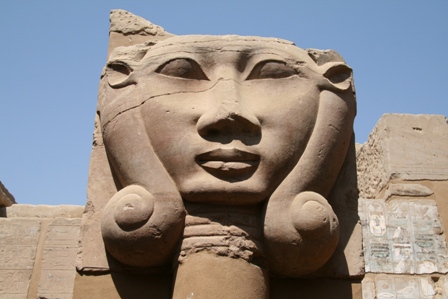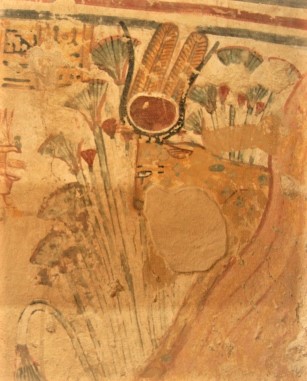In Ancient Egypt there were many different ways of referring to same idea. For instance the concept of fertility could be expressing through the image of god Min, the icon of sematauy, the scene of copulation of Nut (the sky) and Geb (the earth)…
It also happened in the funerary sphere and with goddess Hathor. Many verbal and artistic expressions were used in ancient Egypt to refer to the entrance of the dead into the Hereafter from the hand of this goddess.
Hathor’s versatility.
This ancient Egyptian divinity represented as a cow, had many attributes:
- She was related to the sky, for that reason her name meant “The House of Horus“.

- Hathor was also a lunar deity. In fact it is well know the relationship of bovines with the moon, due to the assimilation of horns with the crescent moon.
- It was represented as a cow; and as a milk producer, she was the nurse par excellence.
- For that reason she was a goddess of maternity.
- She was also goddess of love, feast and drunkenness.
- As a funerary deity she was associated with the West.
As a lunar and western deity, goddess Hathor was an invaluable aid in entering into the world of the dead. And in Ancient Egypt we find three different ways of expressing it.
Hathor lunar.
In Ancient Egypt death and night were similar. In the dark sky where the dead had to navigate the only light that he could see was the moon, Hathor.
the guide of the boat, who keeps ropes kasu in front of the rudder in the West ways… the lady of the light, who guides the Big One who is tired .
Coffin Texts IV, 332
In this regard it is very interesting one of the ways to depict goddess Hathor in Ancient Egypt: a frontal image with two lateral ringlets framing her face.

Open the Occident. Praises are given. The jubilee starts when Hathor gives the double ringlet.
Coffin Texts II, 109.
…my two ringlets get open and the face of Hathor makes lighter to me. Hathor holds her arms out.
Coffin Texts VI, 533
Hathor illuminates the way.
To open the ringlets means in the imaginary of ancient Egypt to see the moon; so it is the access to the light after the darkness of the death. Goddess Hathor is the moon, which allows the vision during the night, because she illuminates and guides the deceased in.
The two ringlets of Hathor separate, as if they were curtains, and the deceased discovers Hathor’s face, as if it was a window that lets the light come in. Hathor’s face gets lighter, like the moon in the dark sky. Hathor/moon/light allows the dead to see during the night and reach the Hereafter.
The Dead is in the Hathor’s Following.
Funerary texts of Ancient Egypt mention the dead as being in the Hathor’s following. That meant, that he was literally following the image of Hathor.

But also it meant that the dead had benefits by being so close to the goddess: he could fight against his enemies, he could perform rites in the Afterlife and from the Late and Ptolemaic Period he could open the Hathor’s shrine.
That signifies that the dead had a direct contact with the goddess. something reserved for privileged. But Moreover, once he opened that door he was face to face with Hathor and in touch with her. That meant that he was in the Hereafter, because she was closely related to the dead’s world.
Hathor, Lady of the Theban Mountain.
In the belief of ancient Egypt, Hathor was “patron saint” of the deceased. Already in the Pyramid Texts of the Old Kingdom Hathor welcomed the dead (Pyr. 1026); she sheltered him and helped him in reaching the eternity.
In the Afterlife the dead was in the entourage of Hathor and she was the main one in the necropolis, that is why one of her epithets was “Hathor at the head of the Necropolis”.
For that reason she became very soon the goddess of The West and the imagery put her on the flank of the mountain, the place of the sunset and where the dead ones got into the Underworld.

Summing up, Goddess Hathor was mentor of the deceased in three ways:
- As the moon; giving him light in the darkeness and guiding him through the night (the death).
- From her shrine. When the dead opens those doors he accesses the goddess Hathor and has the privileges of being in the Herefater.
- As the Lady of the West she welcomes the deceased in the flank of the mountain, the entrace to the realm of the dead.

Muchísimas gracias Mª Rosa Valdesogo, por sus magnificas publicaciones, es una forma muy bella de explicar sus valiosas experiencias , disfruto mucho con sus análisis. Gracias de nuevo. Saludos, Begoña
Gracias a ti Begoña por tus palabras de aliento y sobre todo por leer las publicaciones. Creo que hay que intentar compartir todo lo que se pueda en beneficio del conocimiento y la ciencia. Es una forma de enriquecernos todos y hacer crecer la Egiptología. Saludos